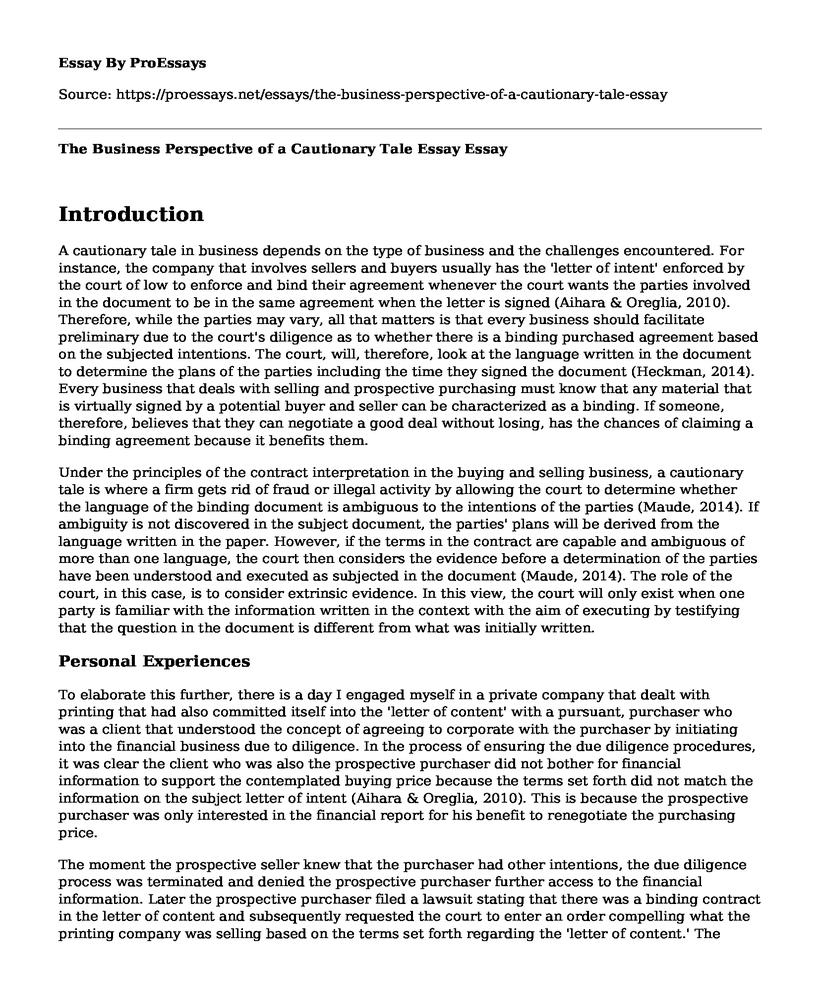Introduction
A cautionary tale in business depends on the type of business and the challenges encountered. For instance, the company that involves sellers and buyers usually has the 'letter of intent' enforced by the court of low to enforce and bind their agreement whenever the court wants the parties involved in the document to be in the same agreement when the letter is signed (Aihara & Oreglia, 2010). Therefore, while the parties may vary, all that matters is that every business should facilitate preliminary due to the court's diligence as to whether there is a binding purchased agreement based on the subjected intentions. The court, will, therefore, look at the language written in the document to determine the plans of the parties including the time they signed the document (Heckman, 2014). Every business that deals with selling and prospective purchasing must know that any material that is virtually signed by a potential buyer and seller can be characterized as a binding. If someone, therefore, believes that they can negotiate a good deal without losing, has the chances of claiming a binding agreement because it benefits them.
Under the principles of the contract interpretation in the buying and selling business, a cautionary tale is where a firm gets rid of fraud or illegal activity by allowing the court to determine whether the language of the binding document is ambiguous to the intentions of the parties (Maude, 2014). If ambiguity is not discovered in the subject document, the parties' plans will be derived from the language written in the paper. However, if the terms in the contract are capable and ambiguous of more than one language, the court then considers the evidence before a determination of the parties have been understood and executed as subjected in the document (Maude, 2014). The role of the court, in this case, is to consider extrinsic evidence. In this view, the court will only exist when one party is familiar with the information written in the context with the aim of executing by testifying that the question in the document is different from what was initially written.
Personal Experiences
To elaborate this further, there is a day I engaged myself in a private company that dealt with printing that had also committed itself into the 'letter of content' with a pursuant, purchaser who was a client that understood the concept of agreeing to corporate with the purchaser by initiating into the financial business due to diligence. In the process of ensuring the due diligence procedures, it was clear the client who was also the prospective purchaser did not bother for financial information to support the contemplated buying price because the terms set forth did not match the information on the subject letter of intent (Aihara & Oreglia, 2010). This is because the prospective purchaser was only interested in the financial report for his benefit to renegotiate the purchasing price.
The moment the prospective seller knew that the purchaser had other intentions, the due diligence process was terminated and denied the prospective purchaser further access to the financial information. Later the prospective purchaser filed a lawsuit stating that there was a binding contract in the letter of content and subsequently requested the court to enter an order compelling what the printing company was selling based on the terms set forth regarding the 'letter of content.' The prospective seller was surprised with the upset of the lawsuit and was forced to pay a lot of money related the legal fees because of defending the subjected lawsuit. This was a costly lesson I learned that the letter of content must have a similar agreement by both parties to prevent fraud.
References
Aihara, H., & Oreglia, M. (2010). Letter of Intent. 75-84. doi:10.2172/982086
Heckman, J. (2014). Nauru: A Cautionary Tale. Human Rights Documents Online, 84-101. doi:10.1163/2210-7975_hrd-1216-2015045
Maude, B. (2014). International Buying/Selling Negotiations. International Business Negotiation, 206-230. doi:10.1007/978-1-137-27052-8_9
Cite this page
The Business Perspective of a Cautionary Tale Essay. (2022, Jul 26). Retrieved from https://proessays.net/essays/the-business-perspective-of-a-cautionary-tale-essay
If you are the original author of this essay and no longer wish to have it published on the ProEssays website, please click below to request its removal:
- Strict Product Liability: Calles v. Scripto-Tokai Corp. Case Paper Example
- Unilateral Rights and Exceptional Circumstances: Asda vs. Bateman Case Study
- Essay Example on Raising Capital for Establishing a Fast-Food Business
- Paper Example on Comparing Capital Expenditure of Apple Inc. and Samsung
- Essay Example on Managing Costs in the Restaurant Business: The Essential Strategy
- The Entrepreneurial Life Cycle: A Comprehensive Overview - Essay Sample
- Paper Sample on Aristotle's Influence on Business Ethics: Eudemian & Nicomachean Ethics







